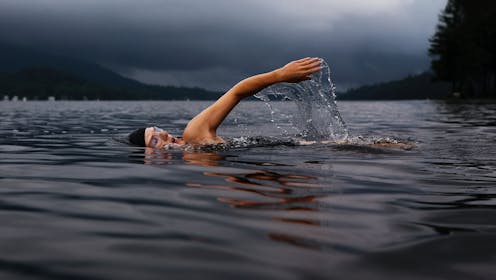The earliest humans swam 100,000 years ago, but swimming remains a privileged pastime
- Written by Jane Messer, Honorary Associate Professor in Creative Writing and Literature, Macquarie University

One of my life’s aims is to swim in as many lakes, rivers, pools and oceans as I possibly can, to use my liberty and swimming skills as freely as I can. I love the feeling of being in a large, fresh body of water, its soft immersive, vast or deep buoyancy.
I’ve swum in a freshwater lagoon near Acapulco in Mexico, with the guide reassuring us there were no crocodiles in the water that day. I’ve swum in a busy London indoor pool noisy with swimmers thrashing about and in Australia’s only women’s pool[1]. I’ve swum in the Weisser See lake on the outskirts of Berlin, the same lake that my grandmother swam in, before fleeing Germany. At Jaffa’s Alma/al-Manshiyah Beach, in Tel Aviv, I’ve looked up from the sea to the Mahmoudiya Mosque’s minaret.
I’ve marvelled at finding myself in waters so far from home. It turns out that my ability to swim makes me part of an elite.
Review: Shifting Currents: A world history of swimming – Karen Eva Carr (University of Chicago Press)
Karen Eva Carr opens Shifting Currents[2] with the startling information that today worldwide – for all Earth’s many rivers, creeks, lakes, ponds, seas and oceans, to say nothing of built pools, canals and theme parks – the majority of people can’t swim. People might bathe and wash their clothes in rivers and lakes, or undertake ritual ablutions in bathhouses, but the vast majority must keep their feet on the ground.
Yet the earliest humans from over 100,000 years ago taught themselves how to swim, for food and for pleasure. There is a long history of human swimming for utility and leisure, amply recorded in pictures from the earliest cave drawings and folk narratives.















